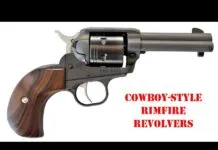When a friend of mine bought a used Iver Johnson M1 Carbine, he got more than he bargained for. Since the seller talked like he knew what he was doing, my friend accepted some reloads along with the gun, thinking that the ammo was just another bonus to the good deal he had made. When one of the loads exploded in his face-embedding a portion of the wooden stock in my friends forehead-it became obvious that the previous owner should have been a politician. Then my friend would have known not to trust him.
Assessing the damages to the carbine, we found that it had jammed with the bolt toward the rear, but had extracted the damaged cartridge. The extreme blow-back force from the ruptured shell had split the side of the stock, and the extractor had suffered damage from being blasted out of its nest in the bolt. The cartridge case had ruptured just ahead of the head, where the case starts to get thinner. The pressure had still been quite high when the bolt was unlocked and when the case head cleared the chamber-more pressure than the unsupported case could stand.
From the initial inspection, there appeared to be little damage to any of the metal parts other than the extractor and the recoil spring. I felt that the damage to the extractor could probably be repaired by peening the raised portion of the metal back into its original position. (As it turned out, it needed replacing.) It was impossible to determine whether the recoil spring was damaged in the explosion, or was stretched out of shape when the weapon was disassembled improperly.
An examination of one of the unfired cartridges that came with the carbine suggested they were made by a reloader lacking experience, good judgment, or both. There was a mixture of two obviously different types of powder in the cartridges, and they hadnt been partitioned from each other with something like Dacron Fiberfill. The reloader had broken a Cardinal Rule of reloading: Dont experiment with something you dont know anything about.
Mechanical Repairs
From my supply of spare parts, I was able to come up with an updated trigger group with the push-button safety to replace the earlier swivel safety. I did not, however, have an extra extractor, since these are a weak point on those guns and are in short supply in used condition. I ordered one from The Gun Parts Corp.
Due to smearing of metal on the surfaces of the extractor, I missed a small ridge of metal which held the extractor in place. After peening out the damaged and displaced metal to make the part look as good as it did before the accident, I assembled the parts into the bolt and found that there wasnt anything to keep the extractor in place. It was obvious that the extractors spring-loaded plunger needed to be caught by something to help keep the extractor in place, but the metal had been damaged in this area and it was possible that that feature was smeared over. I was going to drill a small detent for the plunger to seat into, a cure that would have worked very well, but thought that I might compare the new and repaired one before doing that. It turned out that the extractor had a small ridge which served the purpose, so I chose to use the new part instead of modifying the repaired one.
We inspected all parts for safety and renewed their finishes. The parts that didnt have to slide on each other were glass-bead-blasted and cold blued to a matte black finish much like the original had. The other parts were cleaned, then soaked in diluted hydrochloric acid, cold blued, and burnished with a Brownells burnishing brush. The burnishing brush blended the somewhat mottled cold bluing into a smooth gunmetal gray finish that didnt look like a newly blued part.
Stock Repairs/Refinishing
Because the price of original equipment stocks is more than my friend wanted to pay, I agreed to help him splice a piece of walnut into the area that had been damaged. The oil that had soaked into the stock over the years was leached out with Brownells Stock Whiting. This white paste is remarkable in its ability to draw old grease and oil from most woods with very little effort. In extreme cases, where oil has broken down the wood fiber over many years, the oil can be removed but the wood may still left with a dry-rotted appearance. The stuff doesnt perform miracles, but it is quite successful in most cases.
There were a couple of places where the wood in this stock needed to be replaced as the oil had rotted it too much to be usable. We inset a walnut dowel into a drilled hole where the rear lugs Fillister-head screw went through the stock into a threaded metal slug. The rotted wood was displaced with the dowel and Elmers carpenters glue was used to hold the new wood in place.
The whiting powder that we used was made into a thick paste with trichloroethane 1,1,1, although methanol is also recommended. With the stock stripped of its finish, I applied a good pasty coat of whiting compound with a brush and noticed that it picked up a brownish hue almost immediately. This was a good indication that it would take more than one application. Per Brown-ells recommendation, I have always used heat to speed up the process, as I just cant stand to waste the day waiting for something to happen. It only took us an hour to get the stock dried up and rinsed off with clean trichloroethane, so we were ready to match woods and mill out a square-cut recess for the new piece of walnut.
After drying all of the solvent from the stock, I secured it in the milling machines vise, using blocks and spacers to keep from crushing or collapsing the stock. I chose a large-diameter end mill to do the cut, as I always keep the tip speed up as high as practical when routing or milling wood. The smaller the diameter of the cutting tool, the higher rpm must be attained to maintain cutting speed.
The area where all the stock damage had been done was milled away until there was only a smooth right-angle relief which would easily accept a squared-off block in replacement. The surface of the cut was left as cut by the sharp milling cutter, since that insured that the pores wouldnt be filled with sanding dust from any attempt at smooth-ing the cut.
The wood we chose to use for the splice had to be near the same color of the original stock, and we wouldnt know what that would be without going through the oil-removal process. After that was completed, we washed out the whiting residue and saturated the area around the splice site with rubbing alcohol to be able to see what the final shade of brown would be. This is a good way to check what a finish will do to a piece of wood without raising the grain as happens with water.
When clamping a rectangular piece to something that doesnt have a parallel opposing side, I have often used a rubber pad to keep the clamp from slipping off of the irregular or angled surface. This proved to be adequate in the case of the clamping of the repair block on this stock. If the surfaces dont lend themselves to this treatment, then wide rubber bands can be wrapped around the stock and patch to hold them tightly together until the glue has set.
As the rectangular patch would need to have some healthy milling done on it, and the wood would end up fairly thin, I chose to reinforce the joint between the glued-in piece and the parent wood of the stock with some type of metal. The rapid moving of the operating handle in close proximity with the inside of the stock in that region precluded the use of sheet metal inside the stock cavity. I chose, instead, to insert some 3/32-inch aluminum rods into holes drilled from the top downward. Taking care to keep the metal near enough to the inside of the stock so that it wouldnt get ground into when the outside shaping was done, I cut the pieces of rod short enough to allow some walnut doweling to be used to fill the tops of the holes.
Inserting the aluminum rods into the holes, which had been smeared inside with some glue, I drove them down to the bottoms of the holes with a pin punch. After the glue had dried, I cut some short walnut dowels on the lathe and filled the remaining portions of the holes. Cutting small-diameter rods on a lathe, be they wood or metal, can pose a problem, since the rod tends to flex away from the cutting tool as it gets smaller. This causes the rod to be an unequal diameter from one end to the other.
After the glue had cured, the patch was ground off nearly flush with the stocks surface and sanded with an orbital block sander to final shape. For this, I used 100-grit white Durite, an open-grained sandpaper that cuts smoother and wears longer than any other paper on the market. I only stray from this paper when I need a grit finer than 320, and thats only for final finishing when I need to wet sand.
After shaping the splice to a shape that matched the other side of the stock, I blew the joint out with some compressed air and found that there were some small voids in the glue joint which needed filling. The dust from shaping the splice on the disk sander was mixed with cyanoacrylate glue to form a good filler. I use this in small places where I need the filler to exactly match the parent wood, and when I need to get on with the repair without undue waiting for some other filler to dry. The cyanoacrylate glue/walnut powder filler is easily filed smooth before sanding with an ordinary mill-cut bastard file. (I always save any dust from sanding, as there is no way to get a closer match, if filling is needed, than to use the dust from the parent piece of wood. I keep plastic containers of graded wood powder in case I need wood dust and I havent been sanding on the workpiece.)
Following sanding the wood, I used Birchwood Caseys Walnut Filler, a paste that fills the open grain, to accentuate the natural grain pattern, bringing out the interesting qualities of the wood. You just cant pile on too much of the filler, as most of it can be returned to the jar after being wiped off. When the globbed-on filler has flashed off enough to get a dull appearance, it can be wiped into and off of the surface with wiping motions across the grain. To wipe with the grain only tends to scoop it out of the pores. I use cotton bed sheet material to do this wiping; a soft cloth doesnt get down into the grain and remove too much filler.
A wiped-down filling job needs to dry for at least 12 hours, and preferably nearer to 24, or there is a good chance that the finishing medium will act as a solvent and run the filler until the pores arent sharply defined.
For the final finish, we wanted a urethane that wouldnt look like the carbine had just been restored, so I chose Birchwood Caseys Tru-Oil urethane finish. Their Tuf-Sheen is a little harder, but gives a water-clear finish instead of the very slightly yellowed hue that Tru-Oil takes on. The slight hue tends to give the finish some depth and resembles a finish that was done before the advent of modern urethanes.
I spray on all finishes because I lack the patience to rub them on. The rub-on method prescribed on the Tru-Oil jars is an almost foolproof way for someone without much painting experience to do a good job without getting runs. If runs do occur, regardless of the type of varnish, I suggest wiping it away with your finger and resigning yourself to letting the finish dry completely and sanding the irregularities away. If the run is allowed to dry, it will be months or even a year before it can be sanded away without crumbling or discoloring. Tuf-Sheen dries more rapidly than most others, but you can still speed up the process of run elimination by wiping.
Unfortunately, there was just enough oil left in parts of the stock around the trigger area to retard the drying of the urethane, so the first two coats took about three times as long to dry as I was expecting. But, as we werent under any deadline to finish the gun, I exercised an uncharacteristic amount of patience and waited it out. After I had sprayed on seven coats of the varnish, I let it dry for another two days and very lightly skimmed the surface with some wet 400-grit sandpaper, and then rubbed the finish with some DuPont Polishing Compound until we had the sheen of a well-kept carbine, but not the real gloss of an obvious refinishing job.
Reassembly
The metal parts went together well, and there were no areas where the patch impeded the easy assembly of the carbine. We did, however, add some maple toothpicks in the hole in the butt where the buttplate screw had wallowed out the wood. I always coat the toothpicks with Elmers glue before sticking them into the hole and breaking them off. With some soap on the threads of the stock screw to keep it from sticking to the glue, I screwed the buttplate in place the final time.
Before shooting it into the shooting drum, we replaced the awful stamped military rear sight with the nice Williams Guide Receiver Sight from Brownells. We ordered the WGRS M1-CAR with a plain aperture. There are many choices of apertures available so it can be outfitted for different shooters preferences and varying light conditions. The sight is simple; it only needed to be inserted into the carbines dovetail and then the two setscrews tightened. This sight uses a threaded advance for vertical adjustment, and a slide with a locking wedge/screw for windage. All-in-all, a very good, but not fancy sight.
Test Firing
On firing the first shot into the drum, the firing pin failed to dent the primer enough to set off the cartridge. I wasnt pleased with the amount that the firing pin was protruding from the breechface, so I turned the front shoulder off about .020 inch and tried it again. Still no bang. After convincing myself that the receiver hadnt gotten stretched in the blow-up, I tried checking the headspace and found that it was quite excessive-about .022 inch. If you dont have a headspace gauge for a particular chambering, its easy to use a thin piece of lead sheeting or piece of solder between the cartridge head and the breechface to measure the clearance when the action is closed. The action will mash the lead flat and it wont change thickness so you can measure it.
As the headspacing proved to be excessive, I thought that I might try another operating slide which I had in the parts box. After replacing the slide, I checked the headspacing again and found it to be within the expected limits. It was the operating slide which had gotten stretched in the explosion and it wasnt getting the bolt far enough forward to allow the firing pin a full hit on the primer. After assuring myself that the headspacing was good, I fired the gun into the drum and was rewarded by a good, muffled boom.
Conclusion
Now it was time to visit the range to see how the owner felt about the gun now that it was whole again. We had done quite a bit of talking as we went along with the repair together, so I didnt have to go to any special effort to reestablish his faith in the firearm. The gun shot fine.
If there was one lesson learned from this job, it was to avoid ammunition reloaded by someone whose work you arent willing to risk your life on. That cuts the list down to a very, very short one for me.



























